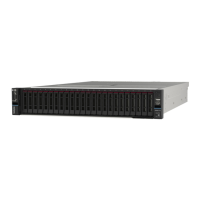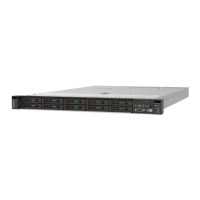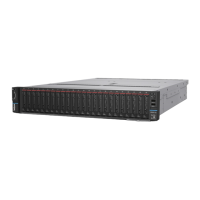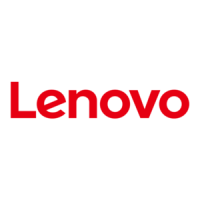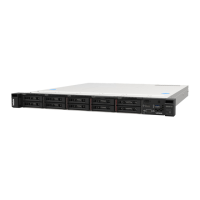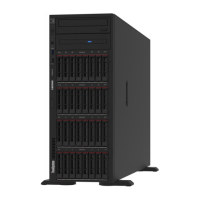Step 3. Determine whether the switch supports auto-negotiation. If not, try configuring the integrated
Ethernet controller manually to match the speed of the switch port. Also, if forward error correction
(FEC) modes are supported, make sure that both the adapter and the switch port have matching
settings.
Step 4. Check the Ethernet controller LEDs on the server. These LEDs indicate whether there is a problem
with the connector, cable, or switch.
If the Ethernet function is implemented on the system board (system board assembly), the Ethernet
controller LED locations are specified in
“Troubleshooting by system LEDs and diagnostics
display” on page 186
.
• The Ethernet link status LED is lit when the Ethernet controller has established link with the
switch port. If the LED is off, there might be a defective connector or cable or a problem with the
switch port. In some cases, a bi-color link LED is used. Green indicates a link at the highest
network speed. Yellow indicates a link lower than the highest network speed.
• The Ethernet transmit/receive activity LED is lit or blinks when the Ethernet controller sends or
receives data over the Ethernet network. If the Ethernet transmit/receive activity is off, make sure
that the switch is powered on, the network is operating, and the correct device drivers are
installed.
Step 5. Check for operating-system-specific causes of the problem, and make sure that the operating
system drivers are installed correctly.
Step 6. Make sure that the device drivers on the client and server are using the same protocol.
If the Ethernet controller still cannot connect to the network but the hardware appears to be working, the
network administrator must investigate other possible causes of the error.
Troubleshooting by symptom
Use this information to find solutions to problems that have identifiable symptoms.
To use the symptom-based troubleshooting information in this section, complete the following steps:
1. Check the event log of the application that is managing the server and follow the suggested actions to
resolve any event codes.
For more information about event logs (see
“Event logs” on page 185).
2. Review this section to find the symptoms that you are experiencing and follow the suggested actions to
resolve the issue.
3. If the problem persists, contact support (see
“Contacting Support” on page 223).
Hard disk drive problems
Use this information to resolve issues related to the hard disk drives.
•
“Server cannot recognize a hard drive” on page 202
• “Multiple hard drives fail” on page 202
• “Multiple hard drives are offline” on page 203
• “A replacement hard disk drive does not rebuild” on page 203
• “Green hard disk drive activity LED does not represent actual state of associated drive” on page 203
• “Yellow hard disk drive status LED does not represent actual state of associated drive” on page 203
• “U.3 NVMe drive can be detected in NVMe connection, but cannot be detected in Tri-mode” on page 203
Chapter 8. Problem determination 201

